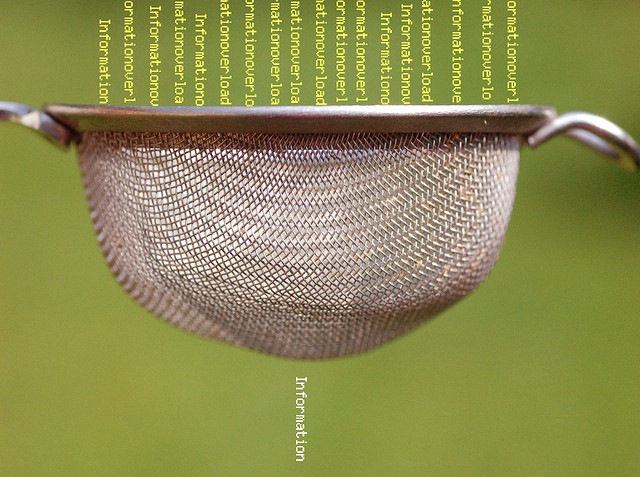Everyone has wrapped their brains around the idea of content creation, and knows they should create amazing content to engage with their target audience. And that’s how content curation, the less known brother of content creation, gets left out in the cold. It is definitely a power that can be harnessed, and it doesn’t just mean collecting but also sharing and commenting. It’s a good way to interact with your visitors and offer them interesting content but also “helps” content creators with a mention.
Remember to keep the target audience in mind. You need to know specific details about them – what are their desires, needs, and passions. Then, you need to tailor the content curation based on their interests. In the end, the interests of your viewers will be the decisive factor on the topics you will curate.
 Photo credit https://www.flickr.com/photos/10ch/3347658610/
Photo credit https://www.flickr.com/photos/10ch/3347658610/What is Content Curation?
[pullquote]Analyzing the source of your traffic is a defining characteristic of content curation. Constantly monitor the curated and shared content to learn how to make it effective.[/pullquote]
Regarding this question, you need to know what curated content is and how it is created. You need to think of it as a process in which you weed through a sea of created content, and expose your target audience to it in a more meaningful form. It does not mean you’re just taking content created by others! You need to restructure the information and make it shareable. A professional content curator picks and polishes the most amazing content and serves it up to the community and also gives credits to the owner.
Why Content Curation?
Over the years, as the content creation trend took over everybody, from a normal person to influencers and brands started developing and sharing content. The amount of content being created and delivered on sites, blogs, and social networks is truly staggering. Thus came along content curation. People took on the challenge of sorting through this immense flux of content and chopping up information so it is easier to digest.
[pullquote]The target audience receives a concentrated form of information without wasting sorting out through tons of content.[/pullquote]
We’ve reached a point where the amount of data on the internet is more than one person can ever read. And as the content creation trend starts to be assumed by website owners, the role of the content curator will shine brighter than ever. A good curator of content will be worth his weight in gold as he’ll be a master at dividing and distributing content.
Content Curation is NOT Content Marketing
The content “world” is split in two sides working towards the same goal. There shouldn’t be any confusion between curation and content marketing. The goals and methods are different and should not be blended into one big SEO mixer. There are some major differences between curatorial intent and creating brand awareness, links, and sympathizers through curatorial techniques.
In this fast paced world we see a lot of content marketers that use a degenerated form of content curation for immediate gratification, short-term visibility in the SERPs, and a painless way fill up pages. On the other hand we’ve got the content curator, who is meticulous and with a keen eye for qualitative content.
How to Manage Large Amounts of Fresh Content
It’s no wonder a content curator needs to have so many qualities given the fact that there aren’t many people who can handle the amount of content that’s created everyday. Ranging from twitter posts to complex guides, if you want to be successful at curating, you need to manage all this data. It may seem like an overwhelming job. Below, I’m going to give you some tips on handling large amounts of fresh content effectively.
[pullquote]You can optimize the process if you’re displaying the curated information not only on social media platforms but also on your website.[/pullquote]
It’s physically exhausting to watch over the whole internet 24/7 in search for fresh and interesting content for you to curate. That’s why you should use automated software to help you monitor sites. Scoop.it is a content curation tool that gives you suggestions from all over the internet related to your topic. You’ll also be able to monitor other content curators that share the same interests as you.
Real Time Content Curation
1. Identify Your Target Audience’s Content Needs
T he foundation for a fruitful content curation career is learning who is your target audience. Tailor content specifically for the people who are actually interested in the subject. Your audience’s tastes and interests essentially decide what content you should curate. If they don’t like what you post, the content might end up being useless data in the sea of billions of information on the internet.
 Photo credit https://www.flickr.com/photos/akire_yrko/3573644189
Photo credit https://www.flickr.com/photos/akire_yrko/35736441892. Develop a Fresh Content Framework
You want to identify what social media networks and platforms your audience likes to follow. Those are the places you’ll want to share the curated content. In the end, you need to constantly look for hot topics that your audience currently talks about. Nothing is more engaging than fresh content that is currently on the front page of every site. Spend time monitoring the news and blogging platforms your audience is using on a daily basis.
3. Real Time Curation
It’s okay to curate and create evergreen content that’s of interest to your target audience even if it’s not really fresh. But a common denominator to all people, no matter the niche is curating news. That’s what gets the attention of people and makes them discuss and share. You need to deliver fresh information and you have to deliver it as fast as you can.
 Photo credit https://www.flickr.com/photos/orangegreenblue/9360248195
Photo credit https://www.flickr.com/photos/orangegreenblue/9360248195Use real-time curation platforms so you can create and share the information while it’s hot. Also, use real-time platforms such as Twitter, which gives you the opportunity to share the same content several times throughout a day to make it visible.
4. Write or Share?
If you’re on the path of becoming a content curator or you’re already one, you need to know you have two choices. You can choose to share, where you’re going to just take the information and forward it without altering. This takes you less time and the information travels faster. And of course there’s the harder path, where you’ll need to filter and feather the content a bit before posting it. There are benefits to both paths, but a truly skilled content creator spends the time to reinterpret the content.
Conclusion
A curatorial process is different from the creation process or the marketing process. The intent is the same, only you also want to build a reputation of being a useful source of information. And even though you want to create awareness for yourself and earn traffic, you also want to provide your audiences with valuable information they can actually use.
Featured image credit: https://www.flickr.com/photos/verbeeldingskr8/363883412




